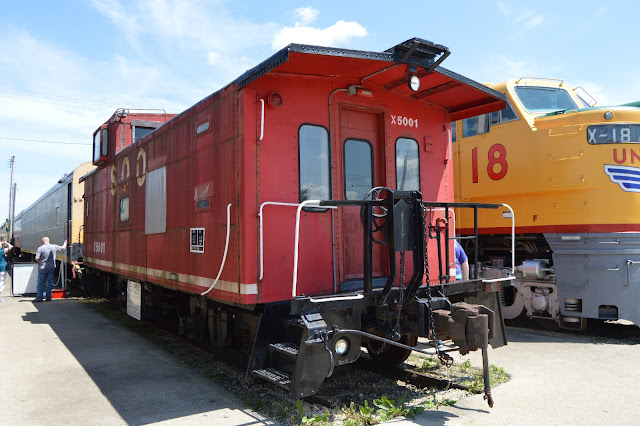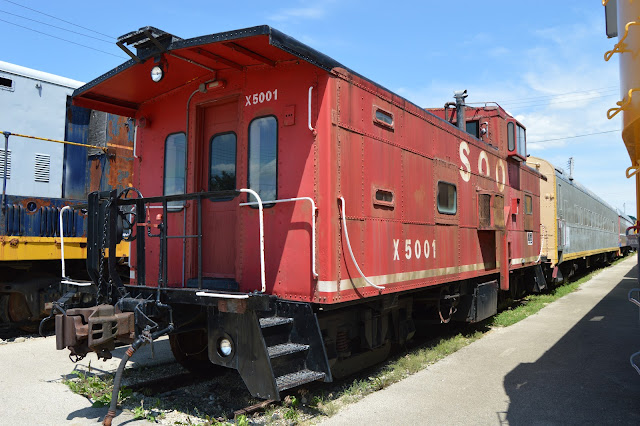This SOO caboose at the Illinois Railway Museum has a sign explaining that it was converted from a drovers caboose to, as a Facebook comment by Sam Carlson called it, a poor man's business car. [I'm sorry that I lost the link for the Facebook post.]
 |
| 20150627 2092rc |
Sam also mentioned that this caboose was not built as a drovers car. Another comment explained what a drover car was:
Larry Ellis Reed Correct me if I'm wrong, but a "drover's car" would have been a hybrid of caboose and day coach as ran on stock trains heading to the major livestock markets (which, in the former Milwaukee's case, would have included the stockyards in Chicago, Milwaukee, South St. Paul, Sioux City, Sioux Falls, Omaha and Kansas City) as accommodated such wanting to sell their cattle, hogs or sheep thus.
A banana messenger's car, which ran on banana trains, was similar.
In any case, drovers thus riding up to market would get return tickets on conventional passenger trains (subject to restrictions on certain high-end prestige trains not accepting Drover's or Banana Messenger tickets).
The drovers were responsible for herding the animals at the intermediate rest stops and at the final stock yards. I assume the banana messengers were responsible for making sure the refers were at the correct temperature.
Some comments confirm that this X-181 was a drovers caboose.
 |
| Maykel Sanz posted Jim Hebner: X-181 was a "one-of-a-kind" caboose. It was originally built in April 1953 by GN's Waite Park shops as X-100. It was renumbered to X-181 in 1966. It spent most of it's life near and around St. Cloud, MN and later GN's Hutchinson branch, pulled by an equally unique NW-5 locomotive. Now in Devil's Lake, ND alongside a bar. |
 |
| Maykel Sanz posted Michael Ballard: I bet that Great Northern caboose was the world's longest caboose, even longer than the drovers' cabooses that the Western Railroad companies used, on their cattle trains. |
 |
| Great Memories and History of Fort Wayne, Indiana posted A little known, five-mile long branch of the Wabash ran between Helmer and Stroh, Indiana. The branch was built in 1899 to serve a cement plant and was out of service by 1945. The town of Stroh must have been bustling with the cement business as a 1901 Stroh newspaper reported the freight agent took in $4800 in freight charges. Stroh also had a limber yard and a combined flouring mill and grain elevator. Of note is the caboose in the photo; it appears to be set up for passengers and LCL freight. Loralee Taylor Dennis DeBruler, your mom helped drive sheep from this depot to the farm. Tom Robison That's called a Drover's caboose. For trains transporting livestock, the drover's caboose was where the stockmen rode. The caboose would have seats/bunks for them. The stockmen took care of the animals during the trip at rest stops. Later on small railroads used them to transport a small number of passengers from stop to stop, which was less expensive than buying a dedicated passenger car. |


No comments:
Post a Comment